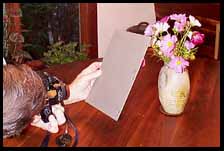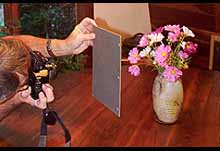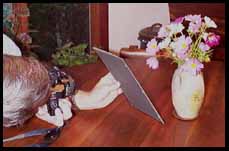Digital camera speeds are usually based on the highlight reading - the speed and meter calibration are set so that the exposure should not oversaturate the sensor, with a small safety factor. There are other criteria, but let's forget about them for now.
An 18% grey card is about two and a half stops less reflective than a perfectly diffuse-reflective object. That means that if the metering system places a grey card reading two and a half stops below the level at which detail will be burnt out, nothing in the picture will be burnt out apart from specular (direct) reflections of light sources and light sources themselves.
In reality scenes often have an average reflectance slightly lower than 18% - somewhere between 12% and 14%* is fairly common. 12% is only about half a stop darker than 18%, so allowing three stops over the meter reading takes care of that. I've measures the recordable brightness range above the metered value for a few cameras when recording to JPEG, and it is usually about three stops. (If you are shooting Raw they can be more).
I think that it is worth finding this out for your camera: how much exposure can you give above the grey card reading before you get to a pixel value of, say, 250? You may find that with a plain, unadjusted gray card reading you are losing some of the crucial range of your sensor.
This all means that if you do meter off a grey card that has been placed in the brightest illumination in the scene, your non-specular highlights will be safe. That's what you want for digital and reversal film. negative film is a different story, and not what we are discussing here. Later, maybe.
What the grey card, used in that way, does not tell you is how dark the darkest part of your scene will be. That depends on the difference in illumination between the darkest and lightest parts of the scene. To do that you would need to place the grey card in the lowest level of illumination, and take a reading - the darkest parts of the scene will be about two and a half to three stops darker than the 18% grey card - few materials have a reflectance below 3%. An aside to this is that no single card placed in full illumination can show the full brightness range of a scene, if there are varying levels of illumination (even one source will cast shadows). This is also the reason why a grey card placed in the scene may not be a good reference for mid gray in the final print, in value terms, even if you are printing in a technically correct method rather than one that suits your aesthetics. It will be OK for white balance, however.
As already mentioned, the use of a grey card turns your meter (including the one in your camera) into an incident meter. True incident meters have some advantages over a gray card, not least because the receptor isn't usually flat. It's fine to use a flat receptor (or a flat card) when photographic flat objects, but it is usually better to use a shaped receptor when photographing three-dimensional objects.
This is why incident meters use domes - they measure light from the sides and from behind (but not directly behind) if used correctly. In technical terms a flat receptor or card has a cosine response and a dome has a cardioid response.
Incident meters are calibrated to match reflective meters at somewhere between around 12.5% and 14% reflectance, depending on the meter manufacturer. There is no fixed value set in the ISO standard for meters.
*One of the earliest photographic grey cards (the 'Neutrowe', 1940) was 14%, by the way.
Best,
Helen

















